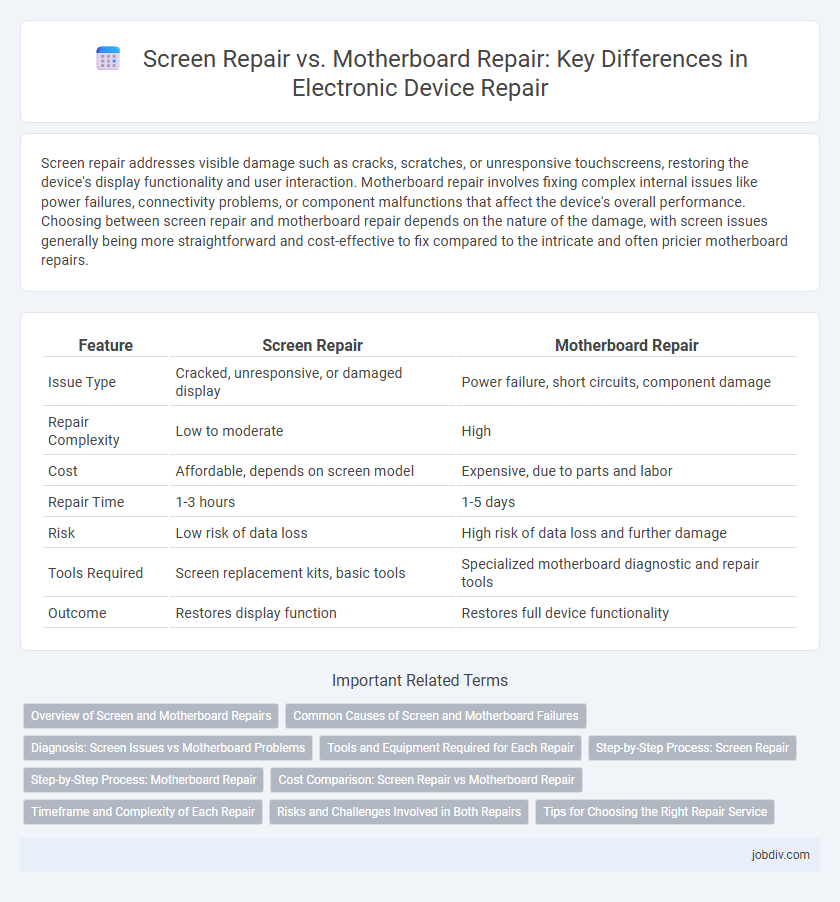Screen repair addresses visible damage such as cracks, scratches, or unresponsive touchscreens, restoring the device's display functionality and user interaction. Motherboard repair involves fixing complex internal issues like power failures, connectivity problems, or component malfunctions that affect the device's overall performance. Choosing between screen repair and motherboard repair depends on the nature of the damage, with screen issues generally being more straightforward and cost-effective to fix compared to the intricate and often pricier motherboard repairs.
Table of Comparison
| Feature | Screen Repair | Motherboard Repair |
|---|---|---|
| Issue Type | Cracked, unresponsive, or damaged display | Power failure, short circuits, component damage |
| Repair Complexity | Low to moderate | High |
| Cost | Affordable, depends on screen model | Expensive, due to parts and labor |
| Repair Time | 1-3 hours | 1-5 days |
| Risk | Low risk of data loss | High risk of data loss and further damage |
| Tools Required | Screen replacement kits, basic tools | Specialized motherboard diagnostic and repair tools |
| Outcome | Restores display function | Restores full device functionality |
Overview of Screen and Motherboard Repairs
Screen repair involves fixing or replacing damaged displays, including cracked glass, dead pixels, and unresponsive touchscreens, which directly affect device usability and visual output. Motherboard repair focuses on resolving issues related to circuits, chips, and connectors that control device functionality, such as power failures, connectivity problems, or hardware recognition errors. Both repairs require specialized tools and expertise, but motherboard repairs are generally more complex and costly due to the intricate nature of circuit-level troubleshooting.
Common Causes of Screen and Motherboard Failures
Screen failures commonly stem from physical damage such as cracks, dead pixels, or backlight issues, often caused by drops or pressure impacts. Motherboard failures typically arise from electrical problems including short circuits, overheating due to dust accumulation, or corrosion from liquid exposure. Identifying the root cause in both cases is crucial for effective repair and long-term device functionality.
Diagnosis: Screen Issues vs Motherboard Problems
Diagnosing screen issues typically involves identifying physical damage, pixel malfunctions, or display backlight failures that directly affect visual output. Motherboard problems require deeper diagnostic tools to detect hardware faults such as damaged circuits, chipset failures, or power supply irregularities that impact overall device functionality. Accurate diagnosis separates superficial screen damage from critical motherboard defects, guiding effective repair strategies.
Tools and Equipment Required for Each Repair
Screen repair requires precision tools such as suction cups, plastic pry tools, heat guns, and replacement screens to safely remove and reinstall the display without damaging delicate components. Motherboard repair demands specialized equipment like multimeters, soldering irons, hot air rework stations, and diagnostic software to detect and fix circuitry issues or component failures. Both repairs benefit from anti-static mats and screw organizers to maintain a clean workspace and prevent damage from electrostatic discharge.
Step-by-Step Process: Screen Repair
Screen repair involves carefully removing the damaged display by detaching the screen from the frame, disconnecting ribbon cables, and isolating the screen assembly. Next, a replacement screen is aligned and connected precisely to the motherboard, ensuring all connectors snap into place without damage. The final steps include reassembling the device, testing the new screen for touch and display functionality, and securing the frame to complete the repair process effectively.
Step-by-Step Process: Motherboard Repair
Motherboard repair involves a meticulous step-by-step process starting with thorough diagnostics using specialized tools like multimeters and oscilloscopes to identify faults. Technicians then carefully desolder and replace damaged components such as capacitors, resistors, or IC chips, followed by reassembling and testing the motherboard for functionality. This precision repair contrasts with screen replacement, which typically involves less technical complexity and focuses primarily on hardware installation rather than component-level troubleshooting.
Cost Comparison: Screen Repair vs Motherboard Repair
Screen repair typically costs between $100 and $300 depending on the device model, while motherboard repair can range from $250 to over $600 due to intricate diagnostics and component replacement. The higher expense of motherboard repair reflects the technical complexity and labor-intensive process involved compared to the relatively straightforward screen replacement. Choosing screen repair is often more cost-effective for visible damage, whereas motherboard repair targets internal functionality issues at a premium price.
Timeframe and Complexity of Each Repair
Screen repair typically requires less time, often completed within 30 minutes to an hour, due to straightforward component replacement. Motherboard repair is more complex, involving intricate diagnostics and soldering that can take several hours to days depending on the damage severity. The complexity of motherboard issues demands specialized skills and equipment, making turnaround times significantly longer compared to screen repairs.
Risks and Challenges Involved in Both Repairs
Screen repair primarily risks damage to delicate display components and connectors, which can lead to screen flickering or touch sensitivity issues if mishandled. Motherboard repair involves complex diagnostics and soldering challenges, with high risks of causing irreversible circuit damage or data loss due to the intricate and compact nature of the board. Both repairs require specialized tools and expertise, but motherboard repairs generally present higher costs and longer turnaround times because of their technical complexity.
Tips for Choosing the Right Repair Service
Screen repair demands precision tools and expertise in display technology, while motherboard repair requires in-depth knowledge of circuit diagnostics and soldering skills. Choose a repair service with certified technicians, positive reviews, and a warranty policy to ensure quality and reliability. Comparing turnaround times and cost estimates helps balance affordability with the complexity of your device's issues.
Screen Repair vs Motherboard Repair Infographic

 jobdiv.com
jobdiv.com